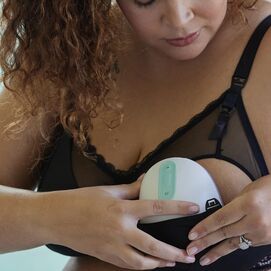Returning to work after the blissful days of maternity leave can be a dreadful experience for any mom, whether you’re a first-timer or you’ve done this before. After all, you’ve been spending your days soaking up precious moments with your baby, and now, the idea of being separated can be downright overwhelming.
If you’re nursing, one of the important things you'll need to think about during this transition is establishing a pumping schedule while at work. This conversation may not be the easiest to have with an employer, but it is necessary to ensure your baby continues to receive the nourishment they need.
To add some peace of mind, it's important to know that there are federal protections in place for pumping mothers, known as the Pump Act.
If this is, in fact, the first time you’ll be pumping at the workplace, you’ve likely got questions. Well, we have answers!
How Often Should I Pump at Work?
The frequency of pumping sessions at work is a common concern for working moms. It's essential to strike a balance that meets both your baby's nutritional needs and your work schedule. As a general guideline, aiming to pump every two to three hours is a good starting point. This interval helps maintain your milk supply and ensures you can provide the nourishment baby needs.
Each mother-baby duo is unique, so flexibility is key. The important thing is to listen to your body and observe your baby's feeding patterns. Some babies may require more frequent pumping sessions, while others may be content with fewer. The goal is to find a rhythm that works for both you and your little one. For more insights on creating an effective pumping schedule, check out this helpful resource.
When Should I Talk to My Boss About Pumping at Work?
The timing of discussing your pumping needs with your boss is important. If possible, addressing this topic before heading off for maternity leave can be highly beneficial. It allows you to set clear expectations and gives your employer enough time to make the necessary arrangements. This proactive approach can help create a supportive work environment.
However, if you've already started your maternity leave or missed the opportunity to have this conversation before leaving, don't worry. You can still have a discussion upon your return to work. The key is to communicate openly and honestly about your needs as a breastfeeding mom.
Our Checklist for Discussing Pumping at Work With Your Boss
Now, let's talk about how you can approach the conversation with your boss effectively. Here's a comprehensive checklist to guide you through the process:
- Provide a Plan: Outline your desired pumping schedule. For example, if you work an eight-hour day, you might propose pumping four times a day, approximately every two hours.
- Ask About Pump Space: Ask about a designated pump space. It should be private, clean, and equipped with an electrical outlet for your convenience.
- Storage Solutions: Ask where you can safely store your expressed milk during the workday. Proper storage is crucial to maintaining the quality of your breast milk. Consider whether there is a refrigerator or a dedicated space available for this purpose.
- Cleaning Facilities: Find out where you can clean your pump parts after each session. Hygiene is important when it comes to expressing breast milk.
What Do I Do If My Boss Won't Let Me Pump at Work?
While federal laws protect your right to pump at work, you might still have issues, unfortunately. If your employer won't accommodate your pumping needs, it's essential to know how to assert your rights.
- Know Your Rights: Familiarize yourself with the federal laws in place to protect breastfeeding mothers in the workplace. The Pump Act, part of the Fair Labor Standards Act (FLSA), ensures that employees have the right to reasonable break time and a private space for expressing breast milk. If your employer is unaware of or unwilling to comply with these regulations, it's crucial to educate them about your legal rights.
- Document Your Requests: Maintain a record of all your interactions and communications regarding your pumping needs with your employer. This documentation can serve as evidence in case you need to escalate the matter.
- Seek Legal Advice: If your employer continues to deny your right to pump at work despite your efforts to educate them and provide reasonable solutions, consider seeking legal counsel. Employment attorneys who specialize in workplace discrimination can provide guidance and support in addressing the issue.
- File a Complaint: If necessary, you can file a complaint with the Wage and Hour Division of the U.S. Department of Labor. They can investigate your case and take appropriate action if your employer is found to be in violation of federal laws.
Remember that your rights as a pumping mother are protected by law, and advocating for those rights is essential not only for yourself but also for working mothers who may face similar challenges in the future.
Enhance Your Pumping Experience with Willow
Pumping at work can undoubtedly feel like a challenging task. It involves not only the practical aspects of expressing breast milk but also navigating potentially difficult conversations with your employer. However, it's crucial to recognize that you are not alone in this journey, and there are resources and support systems in place to assist you.
At Willow, we understand that pumping at work can be an awkward experience. That's why we offer innovative and discreet breast pumps that can make this journey more manageable. Our pumps are designed to fit seamlessly into your daily life, allowing you to express milk conveniently and efficiently. We want to help you overcome the obstacles and discomforts associated with pumping at work.
Enhance your pumping experience with Willow and take the first step towards a more comfortable and convenient journey. To find the perfect Willow pump for you, take our pump quiz, and empower yourself with the tools you need to balance work and motherhood effectively. You got this, mom!













